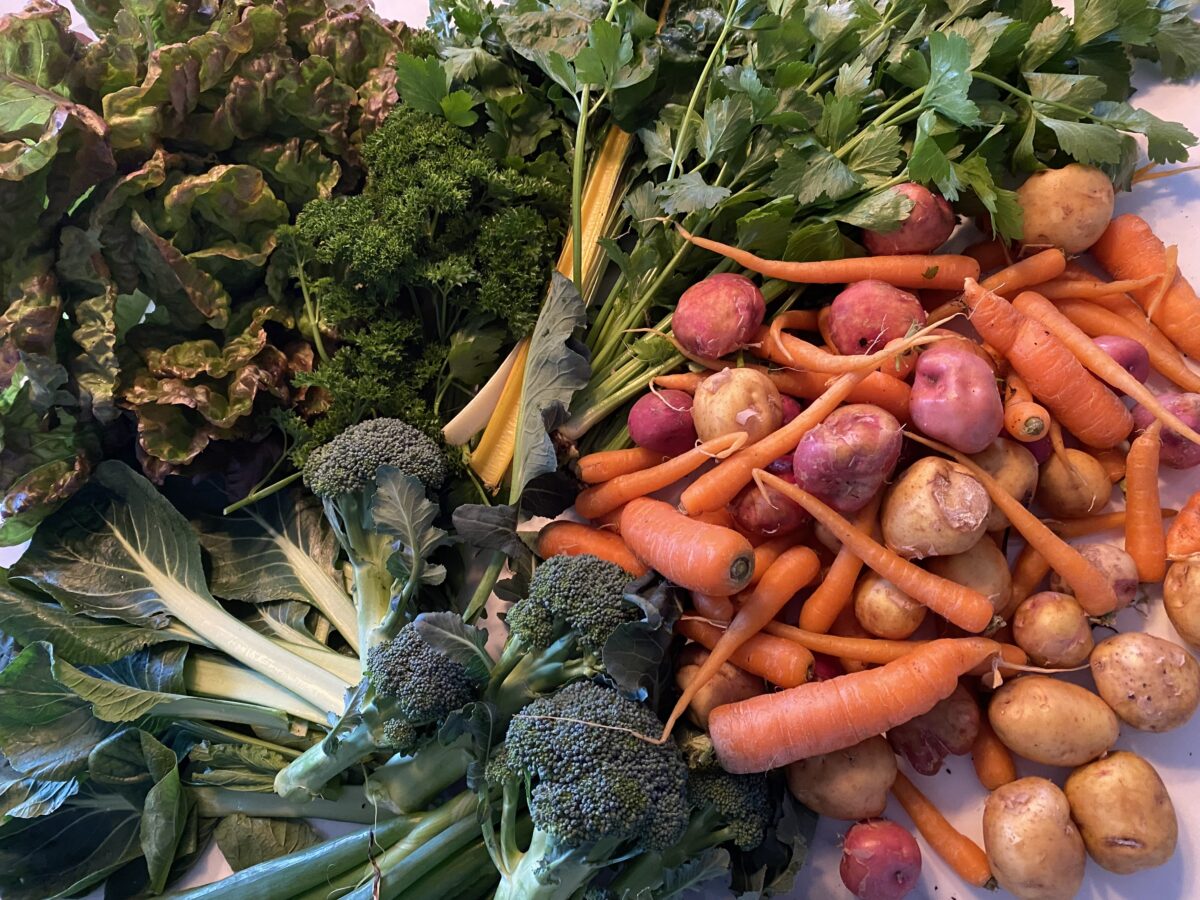Photosymbiodemes are a special case of lichen symbiosis where one lichenized fungus engages in symbiosis with two different photosynthetic partners, a cyanobacterium and a green alga, to develop two distinctly looking photomorphs. We compared gene expression of thallus sectors of the photosymbiodeme-forming lichen Peltigera britannica containing cyanobacterial photobionts with thallus sectors with both green algal and cyanobacterial photobionts and investigated differential gene expression at different temperatures representing mild and putatively stressful conditions. First, we quantified photobiont-mediated differences in fungal gene expression. Second, because of known ecological differences between photomorphs, we investigated symbiont-specific responses in gene expression to temperature increases. Photobiont-mediated differences in fungal gene expression could be identified, with upregulation of distinct biological processes in the different morphs, showing that interaction with specific symbiosis partners profoundly impacts fungal gene expression. Furthermore, high temperatures expectedly led to an upregulation of genes involved in heat shock responses in all organisms in whole transcriptome data and to an increased expression of genes involved in photosynthesis in both photobiont types at 15 and 25°C. The fungus and the cyanobacteria exhibited thermal stress responses already at 15°C, the green algae mainly at 25°C, demonstrating symbiont-specific responses to environmental cues and symbiont-specific ecological optima.
Höfundur: admin

Bændablaðið birti í vikunni tvær greinar sem fjölluðu um grænmetisverkefni sem unnið hefur verið að hjá Matís síðustu misseri. Annars vegar var fjallað um verkefni sem miðar að því að byggja upp hnitmiðaða þekkingu á valkostum fyrir pökkun á grænmeti og hins vegar verkefni sem sneri að því að fullnýta hliðarafurðir grænmetisframleiðslu og möguleika til vöruþróunar úr þeim hráefnum.
Fyrri greinin sem bar yfirskriftina ,,Vilja leysa grænmetið undan plastfargani” fjallar um verkefnið Áskoranir við pökkun grænmetis sem Ólafur Reykdal, verkefnastjóri hjá Matís hefur stýrt og er unnið í samstarfi við deild garðyrkjubænda í Bændasamtökum Íslands, Sölufélag garðyrkjumanna og Samtök sunnlenskra sveitarfélaga með styrk frá Matvælasjóði. Vonast er til þess að verkefnið leiði til framfara við pökkun
ýmissa matvæla þó að grænmeti sé séstaklega til rannsóknar hér og greiði einnig leiðina fyrir nýjar tegundir pökkunarefna.
Greinina má lesa í heild sinni á blaðsíðu 16 í Bændablaðinu og hér: Bændablaðið 19. október 2023
Seinni greinin fól í sér viðtal við Evu Margréti Jónudóttur, verkefnastjóra hjá Matís en hún fjallaði um verkefnið Verðmætaaukning hliðarafurða frá garðyrkju sem Rósa Jónsdóttir, fagstjóri lífefna, stýrir. Verkefnið er unnið í samstarfi við Orkídeu og Bændasamtök Íslands með styrk frá Matvælasjóði og miðar að því að koma blómkálsblöðum, spergilkálsblöðum, rósalaufblöðum, tómatblöðum, gúrkublöðum og gulrótargrasi í betri not en nú er gert. Það gera þau með því að rannsaka næringargildi og lífvirkni en einnig þróa vöruhugmyndir úr þessum hráefnum. Verkefnið mun stuðla að sjálfbærni grænmetisgeirans á Íslandi og aðstoða við þróun hans í tengslum við aukna verðmætasköpun, ný atvinnutækifæri og nýjungar. Meginmarkmið verkefnisins er að auka virði grænmetisframleiðslu, bæta nýtingu og auka sjálfbærni.
Í viðtalinu segir Eva meðal annars: ,, það sem standi upp úr eftir þessa vinnu – og vakið helst áhuga hennar – er hversu mörg tækifæri séu til frekari vinnslu á þessu hráefni. „Við höfum verið að sjá töluvert mikla andoxunarvirkni í rósalaufblöðum sem gefur til kynna að afskurður úr rósarækt geti til dæmis verið spennandi hráefni til framleiðslu innihaldsefna í snyrtivörur. Blöð af blóm- og spergilkáli eru síður en svo minna næringarrík en blómið sjálft og engir annmarkar við notkun þeirra
í matvæli”.
Greinina má lesa í heild sinni á blaðsíðum 32 og 33 í Bændablaðinu hér: Bændablaðið 19. október 2023
Results: In general, lower levels of total As were detected in the samples collected in May (39.2–74.5 mg kg−1) compared to those collected in February (72.6–151 mg kg−1). The concentration of arsenate was found to consistently increase along the thallus from the holdfast/stipe (0.78–1.82 mg kg−1) to the decaying fronds (44.4–61.0 mg kg−1) in both months, and AsSug-SO3 was the dominant AsSugar in the majority of samples. The extraction efficiency was lower in fresh samples (64–77%) than in freeze-dried (95–116%) from the same month. Water-soluble, polar AsLipids, and residual As concentrations, were generally highest in February, and the non-polar AsLipids accounted for <0.42% of totAs in all samples.
In recent years the number of non-indigenous marine species has been increasing in Icelandic waters. In May 2019, a razor shell (Ensis sp.) was found for the first time in Iceland. Since then, living and empty razor shells have been discovered at several locations in Southwest Iceland. Upon morphological examination, the specimens were thought to belong to either Ensis leei or Ensis terranovensis, both native to the east coast of North America. Molecular analysis, using COI and 16S rRNA markers,
showed that the Icelandic specimens belong to the latter species. Native populations of Ensis terranovensis have, until now, only been reported in Newfoundland, Canada. This represents the first record of E. terranovensis outside its native range. The Newfoundland’s razor shell has most likely arrived in Iceland as larvae discharged with ballast water. Based on the sizes of specimens found in Iceland, the species is likely to have arrived several years prior to this first record. Presumably it has already established viable spawning populations that are likely to spread along the coast
Aquaculture of the lumpfish (Cyclopterus lumpus L.) has become a large, lucrative industry owing to the escalating demand for “cleaner fish” to minimise sea lice infestations in Atlantic salmon mariculture farms. We used over 10K genome-wide single nucleotide polymorphisms (SNPs) to investigate the spatial patterns of genomic variation in the lumpfish along the coast of Norway and across the North Atlantic. Moreover, we applied three genome scans for outliers and two genotype–environment association tests to assess the signatures and patterns of local adaptation under extensive gene flow. With our ‘global’ sampling regime, we found two major genetic groups of lumpfish, i.e., the western and eastern Atlantic. Regionally in Norway, we found marginal evidence of population structure, where the population genomic analysis revealed a small portion of individuals with a different genetic ancestry. Nevertheless, we found strong support for local adaption under high gene flow in the Norwegian lumpfish and identified over 380 high-confidence environment-associated loci linked to gene sets with a key role in biological processes associated with environmental pressures and embryonic development. Our results bridge population genetic/genomics studies with seascape genomics studies and will facilitate genome-enabled monitoring of the genetic impacts of escapees and allow for genetic-informed broodstock selection and management in Norway.
Production of fish meal and plant-based feed proteins continues to increase to meet the growing demand for seafood, leading to impacts on marine and terrestrial ecosystems. Microbial proteins such as single-cell proteins (SCPs) have been introduced as feed alternatives since they can replace current fish feed ingredients, e.g., soybean, which are associated with negative environmental impacts. Microbial protein production also enables utilization of grain processing side-streams as feedstock sources. This study assesses the environmental impacts of yeast-based SCP using oat side-stream as feedstock (OS-SCP). Life-cycle assessment with a cradle-to-gate approach was used to quantify global warming, freshwater eutrophication, marine eutrophication, terrestrial acidification, land use, and water consumption of OS-SCP production in Finland. Dried and wet side-streams of oat were compared with each other to identify differences in energy consumption and transportation effects. Sensitivity analysis was performed to examine the difference in impacts at various locations and fermentation times. Benchmarking was used to evaluate the environmental impacts of OS-SCP and other feed products, including both conventional and novel protein products. Results highlight the importance of energy sources in quantifying the environmental performance of OS-SCP production. OS-SCP produced with dried side-streams resulted in higher global warming (16.3 %) and water consumption (7.5 %) than OS-SCP produced from wet side-streams, reflecting the energy and water requirements for the drying process. Compared with conventional products, such as soy protein concentrates, OS-SCP resulted in 61 % less land use, while exacerbating the environmental impacts in all the other categories. OS-SCP had more impact on global warming (205–754 %), water consumption (166–1401 %), freshwater eutrophication (118–333 %), and terrestrial acidification (85–340 %) than other novel products, including yeast protein concentrate, methanotrophic bacterial SCP, and insect meal, while lowering global warming (11 %) and freshwater eutrophication (20 %) compared with dry microalgae biomass.
Based on previous farm-level studies, this study hypothesised that production system (conventional, CON; organic, ORG; channel island, CHA) and season would cause variation in the concentrations of macrominerals and trace elements in retail milk. On average, milk retained its status as an excellent source of Ca, P, I, and Mo across different demographics, and a very good source of K, Mg, and Zn for children. Compared with CON and ORG, CHA milk contained higher concentrations of Ca, Mg, P, Cu, Mn, and Zn; and lower concentrations of K and I. Macrominerals did not show a clear seasonal pattern but trace elements were all at lower concentrations during the typical grazing season. Variation in mineral concentrations can have implications to Ca and P supply in children, and I and Zn supply across different consumer demographics; while the seasonal variation was more pronounced than that associated with production system.
The brown seaweed Alaria esculenta is the second most cultivated species in Europe, and it is therefore of interest to expand its application by developing food products. In this study, a lactic acid bacteria consortium (LAB consortium) consisting of three Lactiplantibacillus plantarum strains (relative abundance ~94%) and a minor amount of a Levilactobacillus brevis strain (relative abundance ~6%) was investigated for its ability to ferment carbohydrates available in brown seaweed. The consortium demonstrated the ability to ferment glucose, mannitol, galactose, mannose, and xylose, of which glucose and mannitol were the most favored substrates. No growth was observed on fucose, mannuronic and guluronic acid. The consortium used different pathways for carbohydrate utilization and produced lactic acid as the main metabolite. In glucose fermentation, only lactic acid was produced, but using mannitol as a carbohydrate source resulted in the co-production of lactic acid, ethanol, and succinate. Xylose fermentation resulted in acetate production. The consortium was also able to utilize laminari-oligosaccharides (DP2-4), obtained after enzymatic hydrolysis of laminarin, and produced lactic acid as a metabolite. The consortium could grow directly on A. esculenta, resulting in a pH decrease to 3.8 after 7 days of fermentation. Incubation of the same seaweed in corresponding conditions without inoculation resulted in spoilage of the seaweed by endogenous bacteria.
Sustainably produced renewable biomass has the potential to replace fossil-based feedstocks, for generation of biobased fuels and chemicals of industrial interest, in biorefineries. In this context, seaweeds contain a large fraction of carbohydrates that are a promising source for enzymatic and/or microbial biorefinery conversions. The thermoanaerobe Thermoanaerobacterium AK17 is a versatile fermentative bacterium producing ethanol, acetate and lactate from various sugars. In this study, strain AK17 was engineered for more efficient production of ethanol by knocking out the lactate and acetate side-product pathways. This was successfully achieved, but the strain reverted to acetate production by recruiting enzymes from the butyrate pathway. Subsequently this pathway was knocked out and the resultant strain AK17_M6 could produce ethanol close to the maximum theoretical yield (90%), leading to a 1.5-fold increase in production compared to the wild-type strain. Strain AK17 was also shown to successfully ferment brown seaweed hydrolysate from Laminaria digitata to ethanol in a comparatively high yield of 0.45 g/g substrate, with the primary carbon sources for the fermentations being mannitol, laminarin-derived glucose and short laminari-oligosaccharides. As strain AK17 was successfully engineered and has a wide carbohydrate utilization range that includes mannitol from brown seaweed, as well as hexoses and pentoses found in both seaweeds and lignocellulose, the new strain AK17_M6 obtained in this study is an interesting candidate for production of ethanol from both second and third generations biomass.






